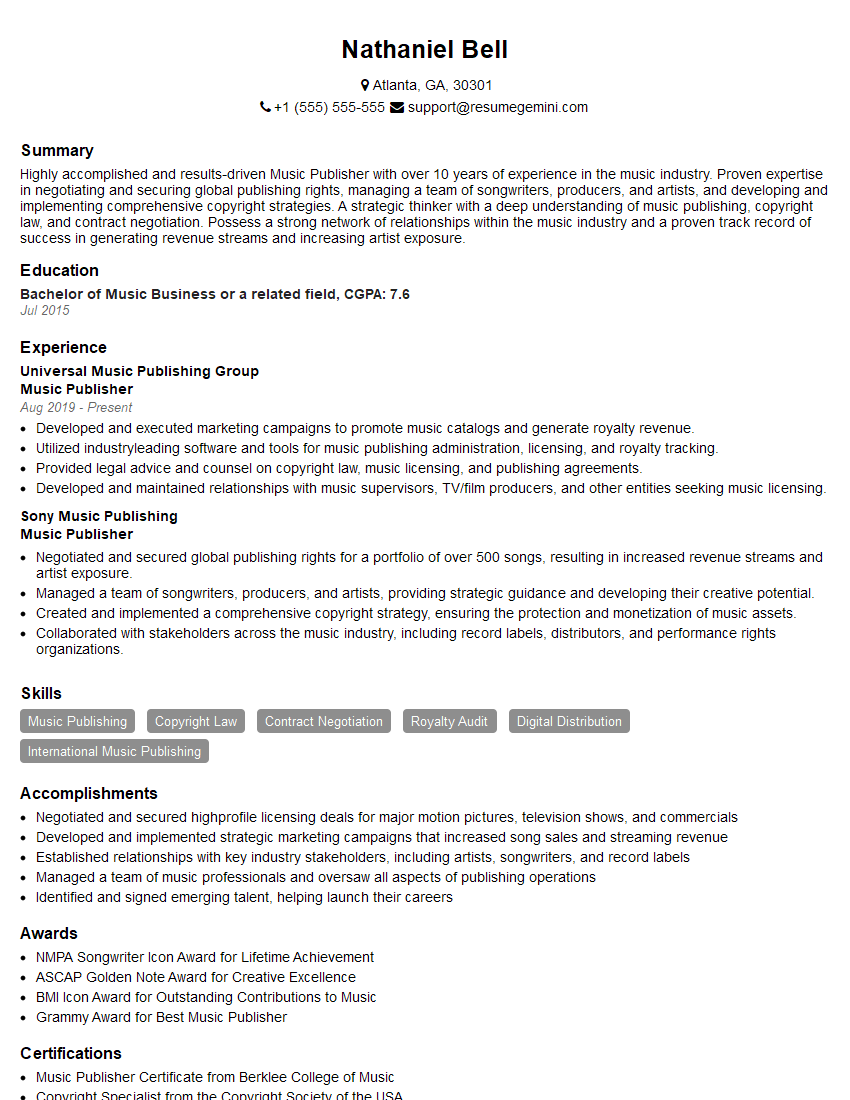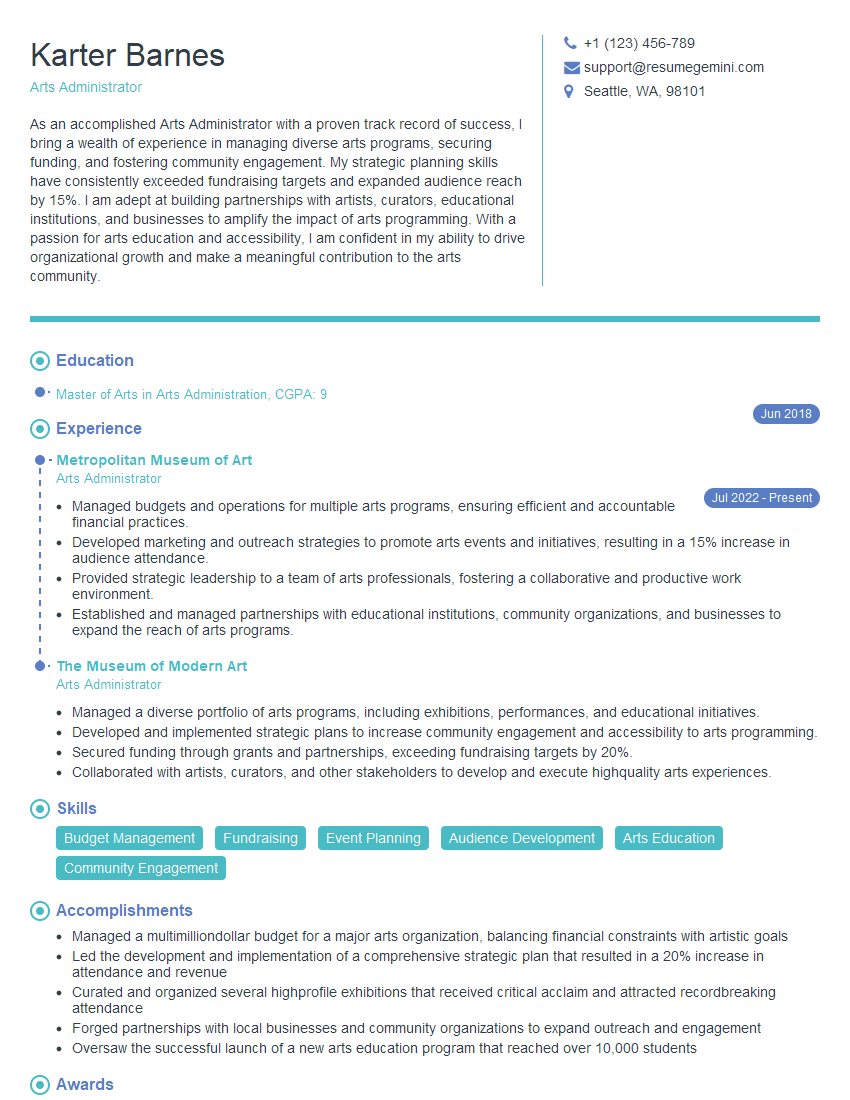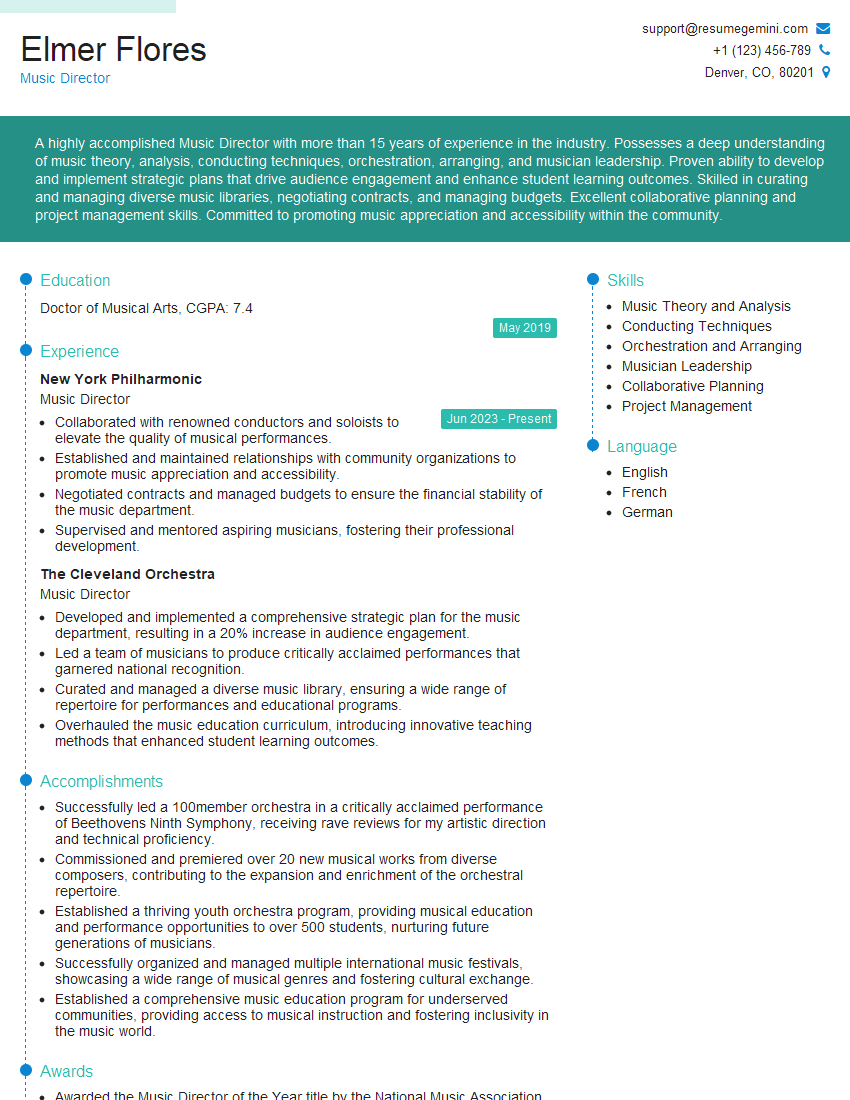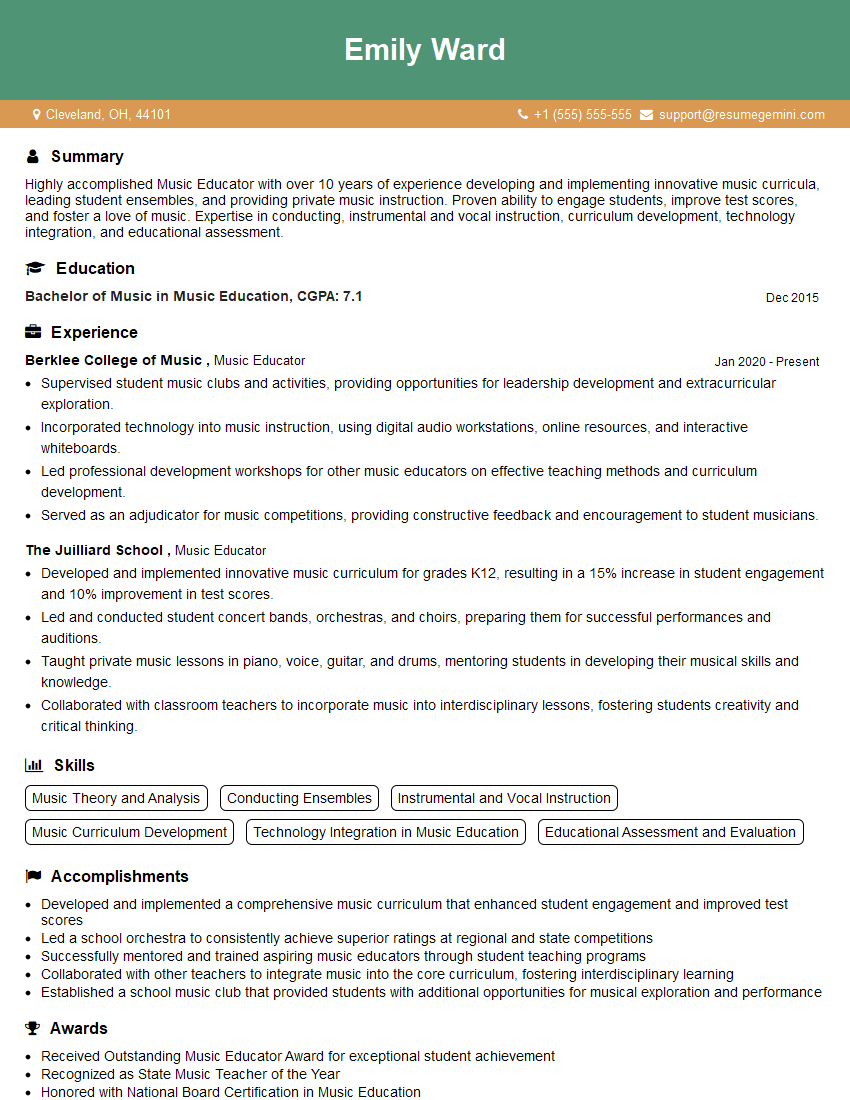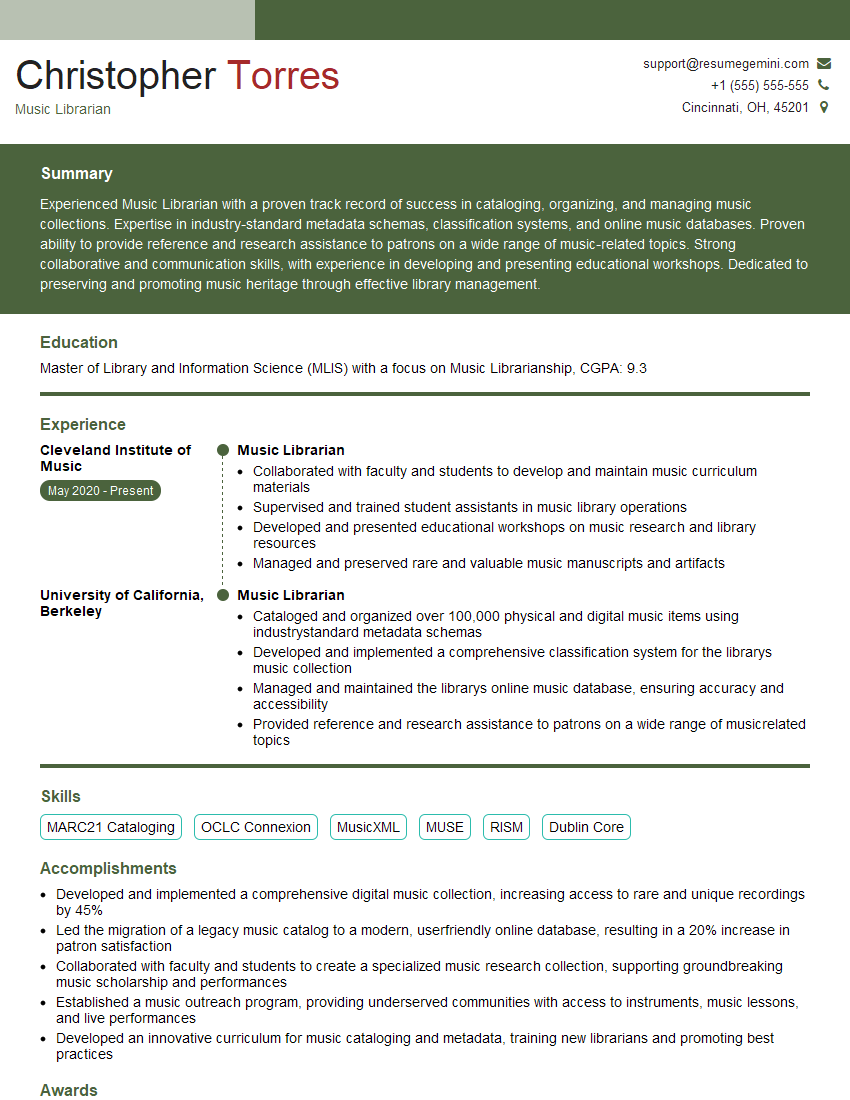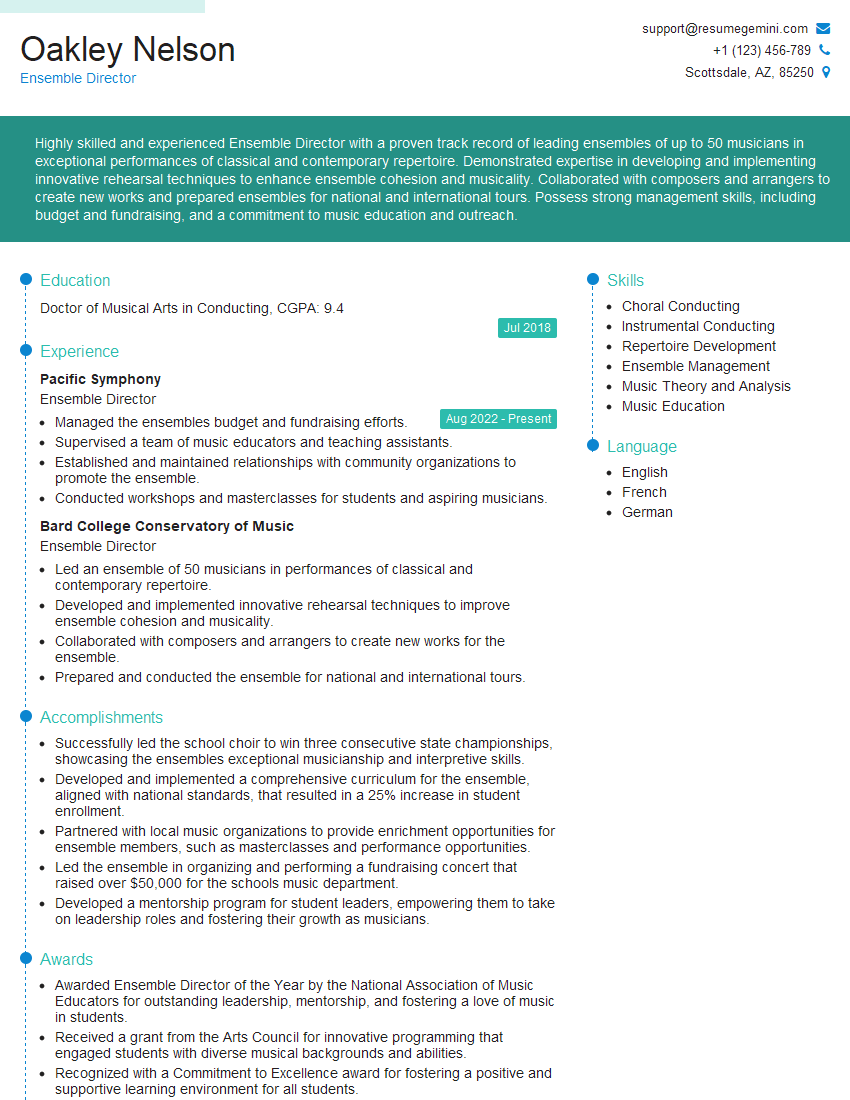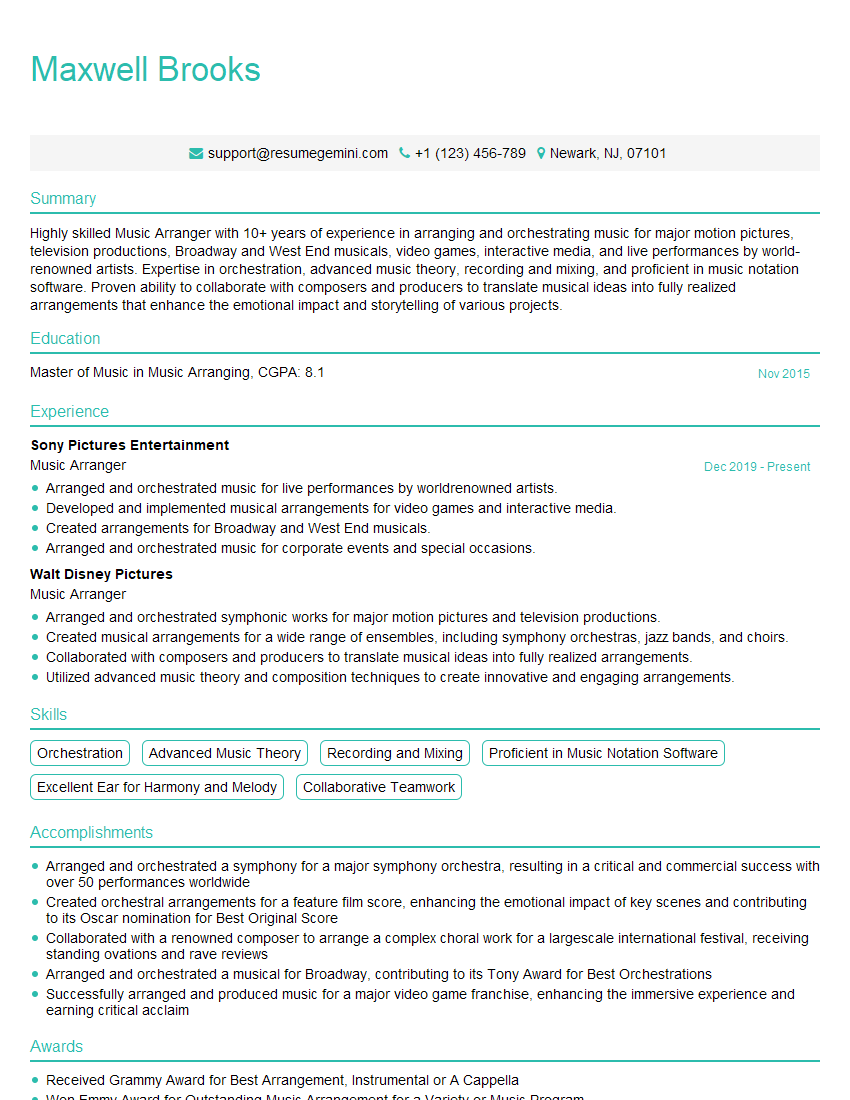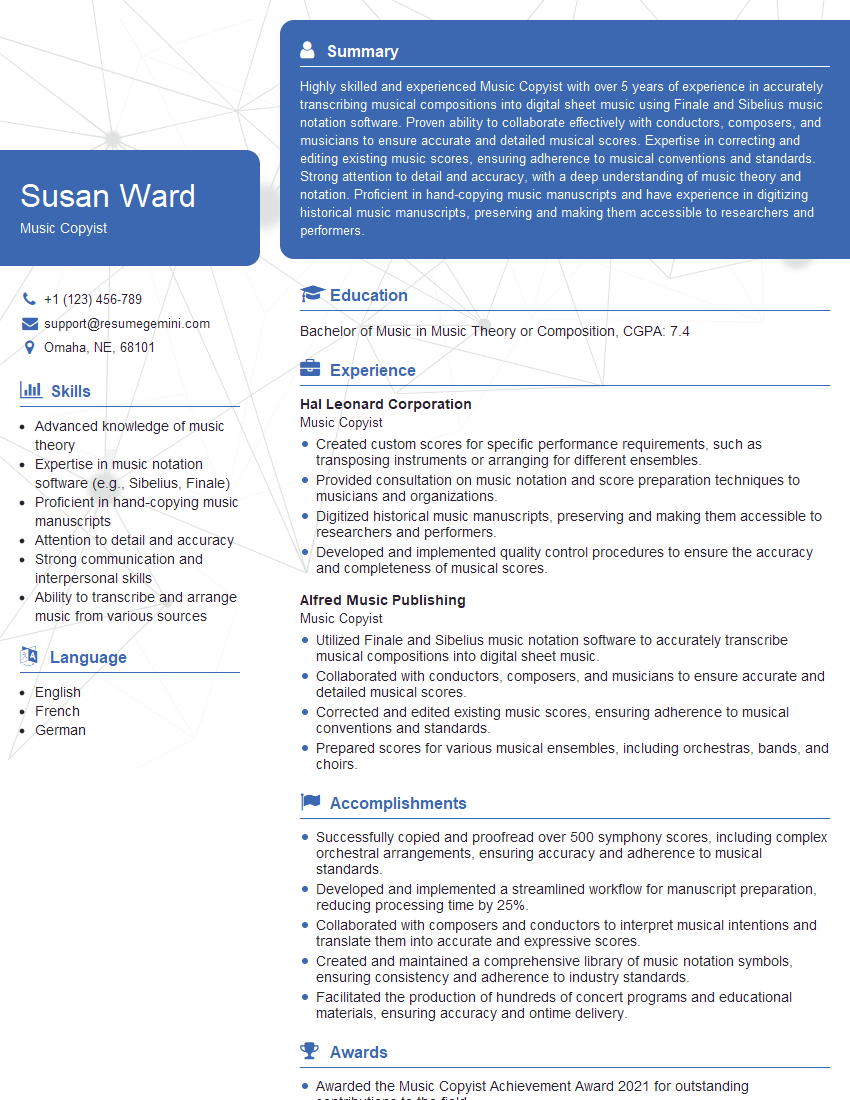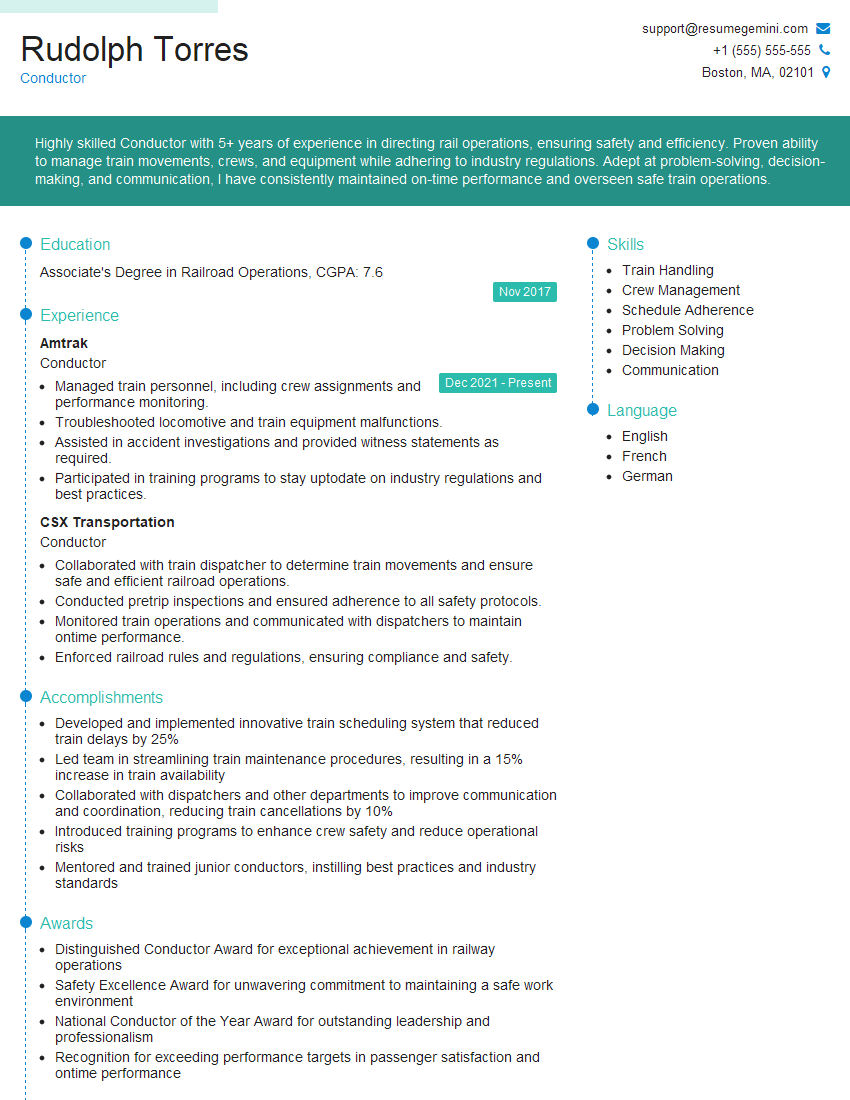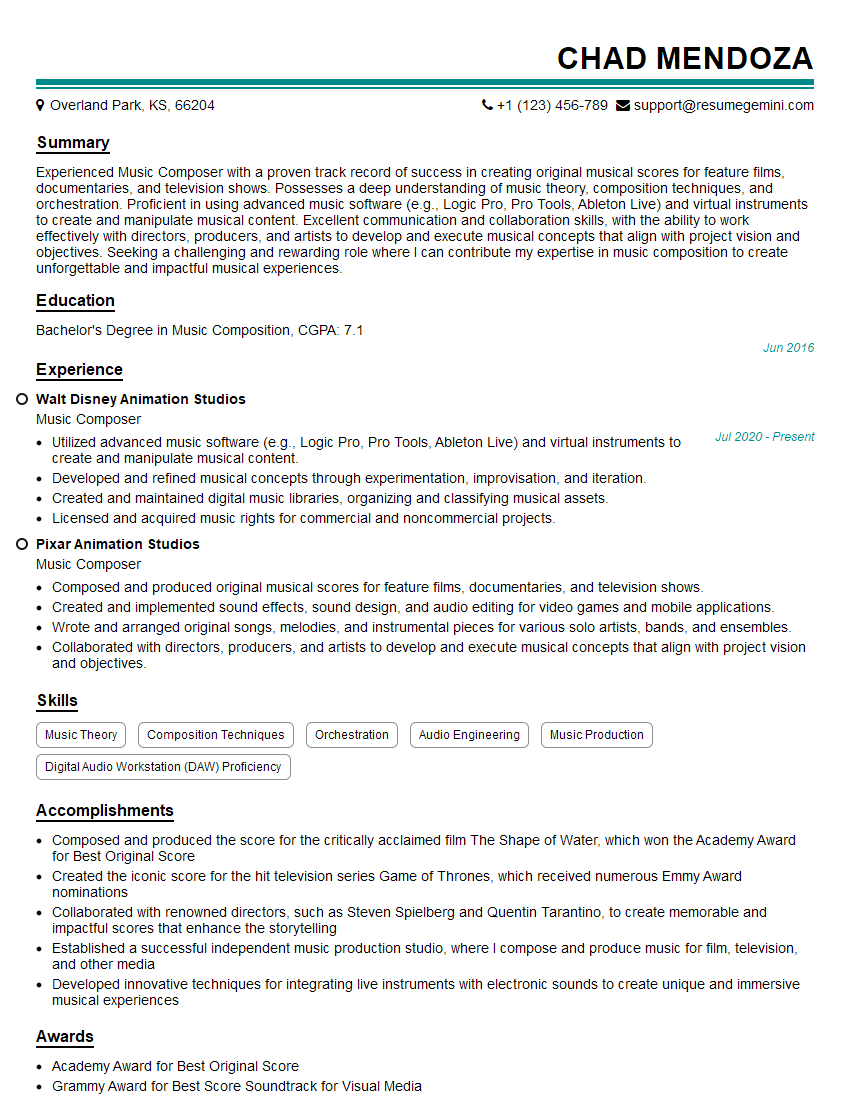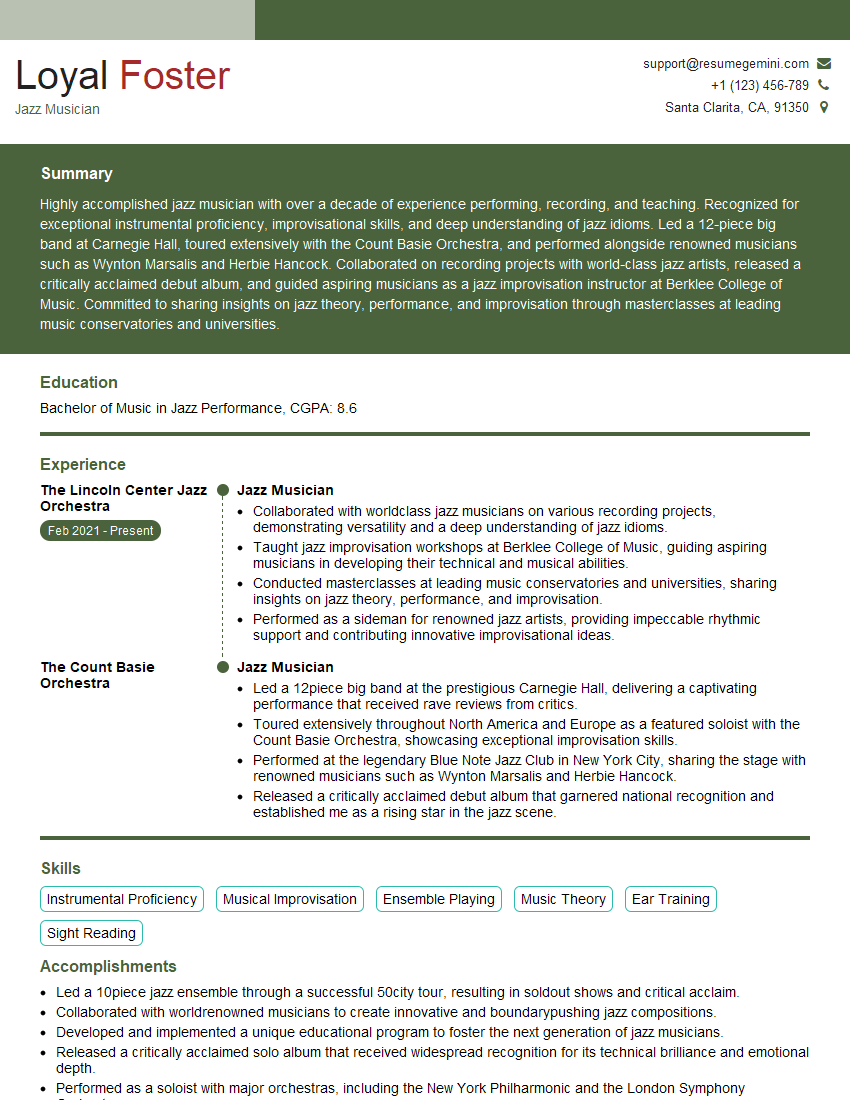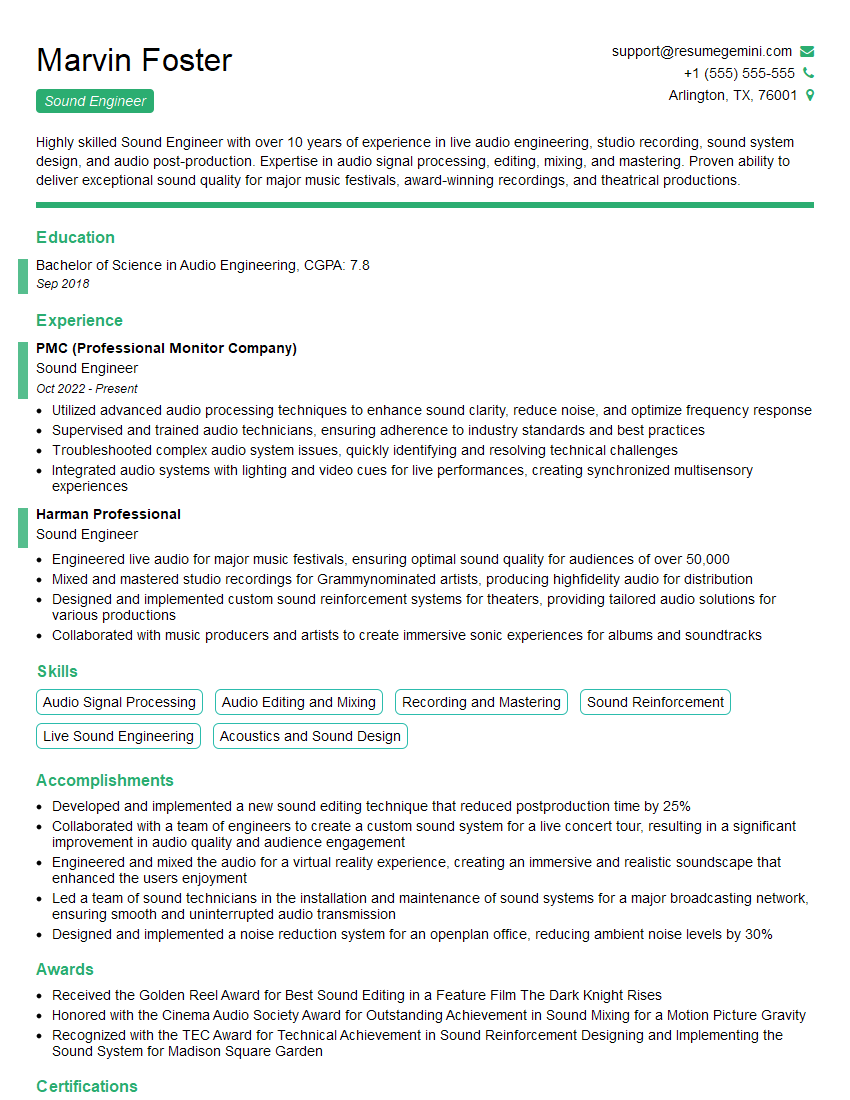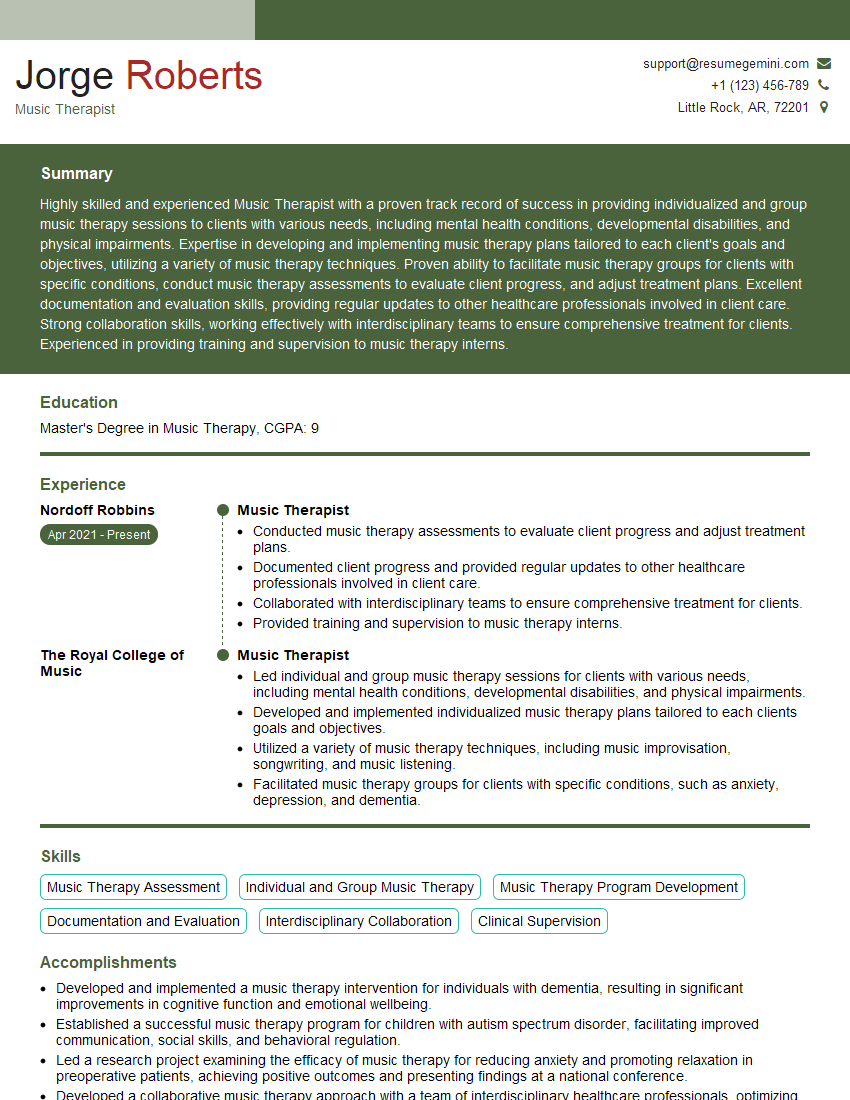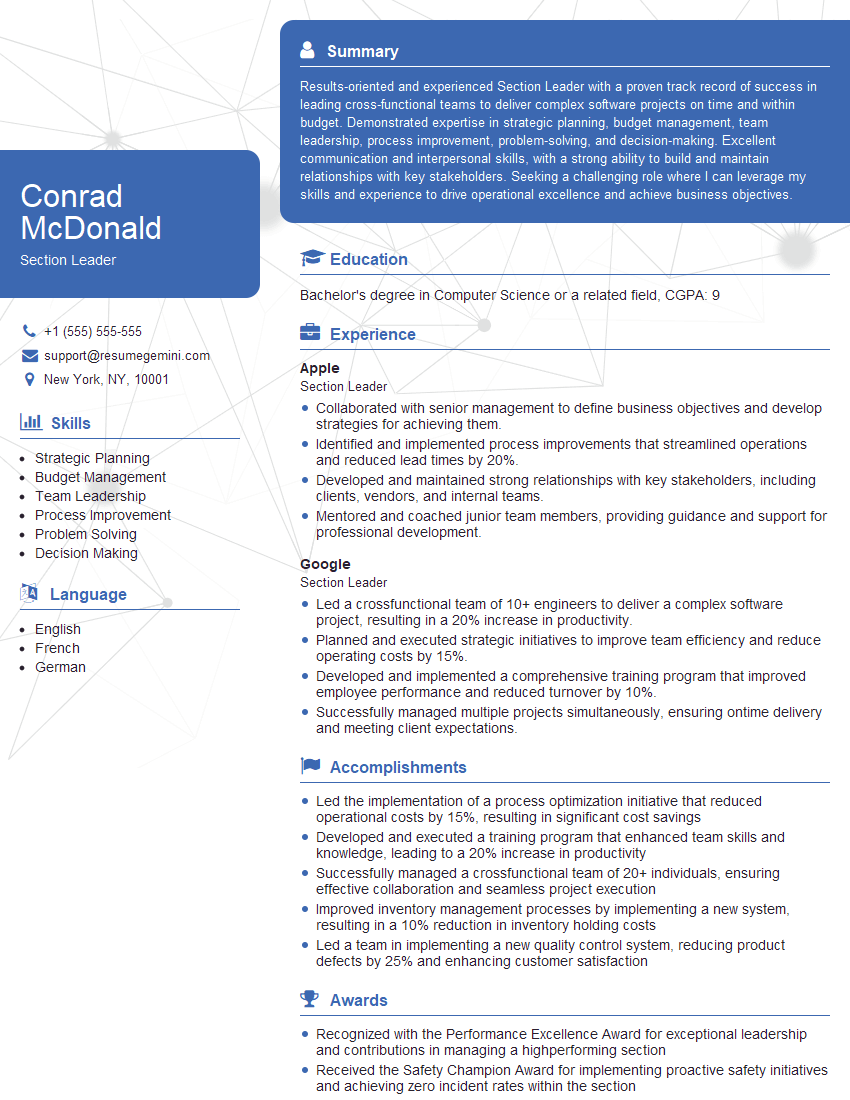Interviews are more than just a Q&A session—they’re a chance to prove your worth. This blog dives into essential Collaboration with Other Musicians and Ensembles interview questions and expert tips to help you align your answers with what hiring managers are looking for. Start preparing to shine!
Questions Asked in Collaboration with Other Musicians and Ensembles Interview
Q 1. Describe your experience working within a large ensemble.
My experience in large ensembles has been formative, teaching me the importance of nuanced listening and precise execution. In a symphony orchestra, for instance, the sheer number of players necessitates a heightened awareness of your part within the larger sonic tapestry. It’s less about individual expression and more about contributing to a cohesive whole. I’ve played in orchestras ranging from 50 to over 100 musicians, and the dynamic is noticeably different. Smaller ensembles allow for more immediate feedback and spontaneous interaction, while larger ones demand a greater level of discipline and preparation. I’ve learned to adapt to the conductor’s vision, responding sensitively to their cues and adjusting my playing to blend seamlessly with the surrounding sections. This has honed my ability to maintain focus during long rehearsals and performances, understanding my responsibility to the overall artistic integrity of the piece.
One particular example is my time playing second violin in a Mahler symphony. The sheer density of the string parts required immense precision and an almost telepathic understanding with my fellow violinists. The slightest deviation could easily be lost in the overall texture, but it could also unravel the delicate balance carefully cultivated by the conductor. It was a demanding yet incredibly rewarding experience, showcasing the collective power of a large ensemble.
Q 2. How do you handle disagreements with other musicians regarding musical interpretations?
Disagreements regarding musical interpretation are inevitable, especially in collaborative settings. The key is open and respectful communication, grounded in a shared understanding of the musical goals. I believe in approaching these situations with empathy and a willingness to compromise. I start by actively listening to my colleagues’ perspectives, striving to understand their reasoning and the artistic choices they are making. Often, the perceived disagreement stems from a lack of shared understanding, rather than an irreconcilable difference in opinion.
I find it helpful to frame the discussion around the overarching artistic vision. For example, instead of saying ‘I think this should be played louder,’ I might ask, ‘How can we ensure this passage conveys the necessary emotional intensity?’ This prompts a collaborative approach to problem-solving rather than a confrontational one. If a compromise cannot be reached, we often refer to the conductor’s interpretation or revisit the composer’s intentions. Ultimately, the goal is to create a cohesive musical performance that respects all involved while maintaining artistic integrity.
Q 3. Explain your process for effectively communicating musical ideas to fellow musicians.
Effective communication in an ensemble goes beyond simply playing the notes correctly. It’s about conveying the nuances of phrasing, dynamics, and articulation clearly and concisely. My process involves a multi-faceted approach:
- Verbal Communication: Clear, precise language is vital. Instead of vague descriptions, I use concrete terminology (‘staccato,’ ‘legato,’ ‘crescendo’) and give specific examples.
- Nonverbal Communication: Body language plays a crucial role. Demonstrating the desired phrasing or articulation can be more effective than words alone.
- Active Listening: Paying close attention to the feedback I receive from others, asking clarifying questions, and showing that I’m truly invested in the collective effort.
- Demonstration: Leading by example. When I understand a difficult passage, I’ll play it accurately and expressively, inspiring others to achieve the same level of skill.
For example, if I want to convey a feeling of urgency in a particular phrase, I won’t simply say ‘play it faster.’ I’ll explicitly explain how I want the rhythmic precision to sound, offering concrete examples to illustrate the desired effect. I might demonstrate the ideal bowing style or show how the articulation needs to be concise and impactful.
Q 4. Describe a time you had to adapt your playing style to fit the needs of an ensemble.
Adaptability is crucial in ensemble playing. In one project involving a jazz quartet, my usual, somewhat flamboyant style needed adjusting to complement the more restrained approach of the other musicians. Initially, my more expressive improvisations clashed with the group’s overall tone. I realized I needed to temper my playing, focusing on subtlety and nuance rather than bold statements. I consciously scaled back my solos, prioritizing rhythmic interplay and harmonic support over virtuosic displays. I studied the other musicians’ styles closely, listening for their rhythmic phrasing and harmonic choices, and attempted to integrate those elements into my playing. The result was a more cohesive and balanced performance, where every member’s contribution felt organic and integrated.
This experience taught me the importance of listening actively to other musicians and understanding the musical context. It reinforced that effective collaboration means adapting your style not only to the music itself but also to the individuals you’re playing with, aiming for a unified whole that is greater than the sum of its parts.
Q 5. How do you contribute to a positive and collaborative rehearsal environment?
Contributing to a positive rehearsal environment involves several key elements: Punctuality, preparedness, and respect for everyone’s time are fundamental. I believe in fostering an atmosphere of open communication and mutual respect. This means actively listening to others’ ideas, offering constructive feedback, and approaching disagreements with empathy and a problem-solving mindset. I always strive to create a space where everyone feels comfortable contributing their ideas and opinions. Humor and a positive attitude can go a long way in making rehearsals productive and enjoyable. Sharing my experience and knowledge with less-experienced musicians is a way for me to help everyone grow.
Q 6. What strategies do you use to ensure everyone in the ensemble is heard and valued?
Ensuring everyone’s voice is heard and valued requires a conscious effort. I actively seek input from all members, particularly those who may be less assertive. In group discussions, I encourage everyone to share their perspectives, making sure that quieter members have the opportunity to contribute. I utilize techniques like round-robin discussions where each person gets a chance to speak without interruption. This can be facilitated by asking direct questions to specific individuals or by creating a safe space for people to express their opinions without fear of judgment.
I also make a point of recognizing and celebrating the individual contributions of each musician. Publicly acknowledging their skills and efforts builds confidence and encourages further participation. By creating a culture of appreciation, everyone feels valued and their contributions are acknowledged as essential to the overall success of the ensemble.
Q 7. How do you manage conflicting schedules and commitments within a collaborative project?
Managing conflicting schedules requires proactive planning and clear communication. Early on in a collaborative project, I suggest a meeting to establish a shared calendar and discuss everyone’s availability. We then work together to create a realistic rehearsal schedule that accommodates everyone’s commitments. This often involves prioritizing key rehearsal periods and making use of technology such as online scheduling tools.
Flexibility is essential. If unexpected conflicts arise, open communication is key. I advocate for finding creative solutions, such as rearranging rehearsal times or utilizing online rehearsal tools to bridge geographical distances. By working collaboratively, we can usually find ways to overcome schedule challenges and maintain the momentum of the project.
Q 8. Explain your experience with sight-reading and adapting to unfamiliar musical scores in an ensemble setting.
Sight-reading, the ability to interpret and perform music at first glance, is crucial in ensemble settings where familiarity with all pieces isn’t always possible. My approach involves a multi-stage process. First, I quickly scan the piece to identify key elements like tempo, time signature, and overall structure. This initial overview gives me a ‘map’ of the musical landscape. Next, I focus on individual sections, paying close attention to rhythmic complexities, melodic contours, and harmonic progressions. I often practice challenging passages slowly and deliberately, gradually increasing the speed as I gain confidence. Finally, I integrate my individual part into the ensemble sound, paying attention to dynamics, articulation, and phrasing cues from the conductor or fellow musicians. For example, during a recent performance of a newly commissioned piece for woodwind quintet, I encountered a particularly tricky passage with rapid sixteenth-note runs. By breaking it down into smaller, manageable chunks and practicing each section repeatedly, I was able to master it and contribute successfully to the ensemble’s performance.
Q 9. Describe your approach to resolving technical issues that arise during performances or rehearsals.
Technical issues during rehearsals or performances are inevitable. My approach to resolving them is proactive and collaborative. First, I identify the problem accurately. Is it a tuning issue, a rhythmic discrepancy, or a problem with the instrumentation? Once the problem is identified, I suggest solutions systematically. Often, a simple adjustment in intonation or a quick re-examination of the score’s markings can resolve the issue. I encourage open communication and am always willing to listen to suggestions from fellow musicians. If the problem persists, we can employ troubleshooting strategies. This might involve isolating the problematic passage, practicing it separately, and then reintegrating it into the full performance. For instance, during a recent orchestral performance, a string section experienced a slight intonation issue during a climactic passage. Through collaborative efforts and adjustments to bow placement and pressure, we successfully rectified the problem before the next performance.
Q 10. How do you balance individual expression with the overall cohesion of the ensemble’s performance?
Balancing individual expression with the overall cohesion of an ensemble is a delicate art. It’s like a tapestry, where each thread (individual musician) contributes to the overall beauty (the cohesive performance), while retaining its unique texture and color. My approach involves a careful consideration of the musical context. While personal interpretation is essential for bringing a piece to life, it should never overshadow the overall integrity of the performance. Active listening and responsiveness are crucial; I constantly monitor the balance and blend within the ensemble to ensure that my own playing fits seamlessly within the larger sonic picture. For example, in a jazz ensemble, I might improvise within a given chord progression, ensuring my solo maintains rhythmic cohesion and complements the overall harmonic structure. Similarly, in a classical string quartet, while personal phrasing and tone are important, maintaining a uniform dynamic and tempo with the other players is crucial to the success of the performance.
Q 11. How familiar are you with different rehearsal techniques and methodologies?
I’m familiar with a range of rehearsal techniques, including the Kodály method (focused on vocal training and musical literacy), the Dalcroze method (emphasizing rhythmic movement and improvisation), and the Suzuki method (based on rote learning and imitation). My preference often depends on the specific ensemble and repertoire. For example, with beginner ensembles, I might utilize the Suzuki method, focusing on repetition and gradual progression. With more advanced groups performing complex contemporary works, I might prefer a more flexible approach, incorporating elements of both Kodály and Dalcroze to facilitate exploration of phrasing and interpretation. Effective rehearsal techniques include:
- Setting clear goals for each rehearsal session
- Prioritizing active listening and feedback
- Employing different sectional and full-ensemble rehearsals
- Encouraging creativity and exploration while maintaining discipline and focus
Q 12. Describe your experience working with diverse musical styles and genres within a collaborative context.
My experience spans a wide array of musical styles and genres. I’ve collaborated extensively on projects ranging from baroque chamber music to contemporary jazz improvisations, and everything in between. Working across genres requires adaptability and a willingness to learn. Understanding the nuances of each genre – the rhythmic characteristics of Afro-Cuban music, the harmonic complexities of atonal compositions, the improvisational freedom of jazz – is essential for contributing effectively. For example, in a project involving both classical and folk elements, I had to learn to balance precise intonation and articulation expected in classical music with the freedom and spontaneity found in folk traditions. This demanded meticulous study of each genre’s techniques alongside a willingness to blend and integrate them within the collaborative context.
Q 13. How do you provide constructive feedback to fellow musicians in a way that fosters growth and improvement?
Providing constructive feedback is a skill I’ve honed over years of collaboration. My approach focuses on being specific, positive, and solution-oriented. Instead of saying ‘that was wrong,’ I might say, ‘I noticed that the rhythm in bar 12 was slightly ahead of the beat. Perhaps slowing down slightly at the beginning of that phrase would help maintain the overall tempo.’ I always frame my feedback within the broader context of the ensemble’s goal, emphasizing the importance of the individual’s contribution to the collective effort. This approach encourages mutual respect and trust, fostering a supportive environment for growth. I always focus on specific observable aspects of the performance rather than making sweeping generalizations. For instance, instead of criticizing a player’s overall technique, I would focus on a specific aspect like bow speed or finger placement.
Q 14. Explain your approach to resolving conflicts related to musical arrangements or interpretations.
Conflicts regarding musical arrangements or interpretations are common in collaborative settings. My approach to resolving them involves open dialogue and mutual respect. We begin by clearly articulating each individual’s perspective, understanding the reasoning behind differing viewpoints. We might analyze the score together, referencing relevant historical performance practices or composer’s notes. Compromise is often key; we aim to find a solution that honors each musician’s artistic vision while maintaining the overall integrity of the musical piece. Sometimes, this involves a democratic decision-making process, and sometimes it involves one person’s artistic vision guiding the ensemble. For example, in a recent project, conflicting interpretations of a particular dynamic marking led to a constructive discussion where we listened to different recordings of the piece and ultimately found a middle ground that satisfied everyone involved.
Q 15. How do you ensure that all musicians understand their roles and responsibilities within a project?
Ensuring everyone understands their role is paramount for a successful musical project. It’s not just about handing out parts; it’s about fostering a shared understanding of the musical intention and individual contributions.
- Detailed Part Distribution: I provide each musician with their part, clearly marked with any specific markings or cues. I might include a separate document outlining the overall structure and their role within it (e.g., ‘You are the primary melodic voice in Section A, providing counterpoint to the cello’).
- Rehearsal Planning: Rehearsals are structured to address specific sections and challenges. We’ll start with individual parts, then move to sectional work, and finally, full ensemble runs. This phased approach helps clarify individual roles within the bigger picture.
- Open Communication: I encourage musicians to ask questions – no question is too small. I foster a collaborative environment where everyone feels comfortable voicing concerns or seeking clarification. Regular check-ins help to proactively identify and resolve potential misunderstandings.
- Example: In a recent project involving a string quartet and piano, I created a detailed score breakdown for each musician, highlighting their unique entrance points, rhythmic nuances, and dynamic interactions with other instruments. This ensured everyone felt prepared and confident in their role.
Career Expert Tips:
- Ace those interviews! Prepare effectively by reviewing the Top 50 Most Common Interview Questions on ResumeGemini.
- Navigate your job search with confidence! Explore a wide range of Career Tips on ResumeGemini. Learn about common challenges and recommendations to overcome them.
- Craft the perfect resume! Master the Art of Resume Writing with ResumeGemini’s guide. Showcase your unique qualifications and achievements effectively.
- Don’t miss out on holiday savings! Build your dream resume with ResumeGemini’s ATS optimized templates.
Q 16. How do you handle the pressure of performing in a high-stakes environment with a large ensemble?
Performing in high-stakes environments with a large ensemble demands meticulous preparation and a calm, focused approach. The pressure is real, but it can be managed.
- Thorough Rehearsal: Extensive rehearsal is key. This includes focusing on individual parts, sectional work, and ultimately, full ensemble performances. We’ll simulate the performance environment as much as possible, even incorporating potential distractions.
- Strong Leadership: A confident conductor is essential. My role includes providing clear direction, building the group’s confidence, and maintaining a positive and supportive atmosphere. I also emphasize breathing exercises and mindfulness techniques to manage anxiety.
- Individual Support: I offer individual coaching to address any specific challenges a musician might face, helping to build their confidence and reduce anxiety. I create a supportive environment where everyone feels safe to make mistakes and learn from them.
- Positive Reinforcement: Focusing on the positive aspects of the performance during rehearsals and even before the performance helps to cultivate a positive mindset. Celebrating achievements and progress reinforces team spirit.
- Pre-Performance Routine: Establishing a pre-performance routine, whether it’s a short meditation session or a listening to calming music, can help musicians centre themselves and manage anxiety effectively. This consistency is critical for maintaining focus.
Q 17. Describe your experience using music notation software and collaborative platforms.
Music notation software and collaborative platforms are indispensable tools for modern ensemble work. They significantly improve efficiency and communication.
- Notation Software: I primarily use Sibelius and Finale. These programs allow for the creation of detailed scores, parts, and cue sheets. The ability to easily edit and share changes is invaluable. For example, I recently used Sibelius’s engraving tools to meticulously mark dynamic and articulation changes across all parts in a large orchestral piece.
- Collaborative Platforms: Google Drive, Dropbox, and dedicated music collaboration platforms are frequently used for sharing scores, recordings, and communication. These platforms allow for version control, simultaneous editing (with care!), and quick distribution of updates. For example, using Google Drive to share revised parts with the entire ensemble was vital for maintaining efficiency during a recent project.
- Example: In one instance, we used a combination of Sibelius and Google Drive. I prepared the initial score in Sibelius, then shared the parts via Google Drive. Musicians could then make annotations and comments directly on the PDF files, which helped in addressing any issues quickly and efficiently.
Q 18. How do you maintain effective communication and coordination during remote collaboration sessions?
Remote collaboration presents unique challenges, but with the right strategies, it can be highly effective.
- Scheduled Video Conferencing: Regular video conferencing sessions are crucial for maintaining connection and fostering a sense of community. Tools like Zoom or Google Meet allow for real-time interaction and feedback.
- Asynchronous Communication: For sharing materials and updates, email and cloud storage are vital. This allows for flexibility and avoids the need for real-time interaction for every minor update.
- High-Quality Audio Recording and Sharing: High-quality recording and sharing of individual parts and sectional work helps me provide detailed feedback and monitor progress. Cloud-based solutions enable easy access and feedback sharing.
- Clear Communication Protocols: Establishing clear communication protocols, such as designating a point person for each section, ensures that questions and concerns are addressed efficiently.
- Example: For a recent remote project, we used Zoom for weekly rehearsals, Google Drive for sharing scores and recordings, and email for asynchronous communication. This setup allowed for efficient collaboration, even though the musicians were geographically dispersed.
Q 19. How do you contribute to the selection of repertoire for an ensemble?
Selecting repertoire is a collaborative process that involves considering many factors.
- Ensemble Capabilities: The ensemble’s technical abilities and stylistic preferences are paramount. The chosen pieces should challenge the musicians while remaining attainable.
- Artistic Goals: We discuss the artistic vision and goals of the project. This informs the style, period, and thematic coherence of the selected repertoire. For example, we might aim for a program showcasing diversity, a particular composer’s oeuvre, or a specific historical period.
- Audience Engagement: The intended audience needs to be considered. Selecting pieces that are engaging and accessible is important to ensure a successful performance. We might consider the audience’s prior exposure to the style or composer.
- Balance and Variety: We aim for a well-balanced program with variety in terms of style, tempo, and mood to ensure an engaging and fulfilling experience for the audience.
- Example: In one instance, we sought a program balancing virtuosic pieces showcasing the ensemble’s technical brilliance with lyrical works highlighting the emotional depth of the musicians.
Q 20. What are your preferred methods for evaluating the effectiveness of ensemble rehearsals?
Evaluating rehearsal effectiveness involves both objective and subjective assessment.
- Technical Proficiency: I listen for intonation, rhythm accuracy, and technical precision. Are the musicians playing accurately and with good tone? This is a core element of objective evaluation.
- Musical Interpretation: I assess the phrasing, dynamics, and overall musical expression. Are they communicating the emotion and intention of the music effectively? This requires a subjective assessment of musicality.
- Ensemble Cohesion: I assess how well the individual parts blend together to create a unified and cohesive whole. Are the musicians listening to and responding to each other effectively?
- Progress Tracking: I track the ensemble’s progress from rehearsal to rehearsal. Are the challenges being overcome, and is the performance improving?
- Feedback and Adjustments: I incorporate the observations made into the rehearsal process. This allows me to adapt strategies, address challenges, and reinforce successful aspects.
- Example: After each rehearsal, I’ll create brief notes summarizing the strengths and weaknesses observed, focusing on specific sections or technical challenges that require further attention. This data-driven approach ensures continuous improvement.
Q 21. Describe your approach to mentoring or guiding less experienced musicians in an ensemble.
Mentoring less experienced musicians requires patience, encouragement, and personalized guidance.
- Individualized Instruction: I provide personalized attention, focusing on specific areas where the musician needs improvement. This might involve addressing technical challenges, musical interpretation, or performance anxiety.
- Positive Reinforcement: I focus on celebrating their successes and progress, creating a supportive and encouraging environment.
- Modeling Good Practices: I demonstrate good musical practices through my own playing and teaching, serving as a role model for professionalism and musicianship.
- Constructive Feedback: I provide constructive feedback, focusing on both the strengths and areas for improvement. I aim to be supportive and helpful, not critical or demoralizing.
- Resources and Support: I connect them with other resources, such as workshops, masterclasses, or other mentors, to aid their development.
- Example: I recently worked with a young violinist who struggled with intonation. Through individualized exercises, targeted feedback, and positive reinforcement, she significantly improved her intonation and confidence. Her improvement was greatly rewarding for both of us.
Q 22. How do you integrate technology into the collaborative process, such as recording or virtual rehearsals?
Technology has revolutionized collaborative music-making. We use it extensively for both recording and virtual rehearsals. For recording, platforms like Logic Pro X or Ableton Live allow individual tracks to be recorded and edited separately, then combined seamlessly. This is crucial for projects involving geographically dispersed musicians. Imagine recording a string quartet where the cellist lives in London and the violinist in New York – this is easily managed digitally.
Virtual rehearsals utilize platforms such as Zoom or Google Meet, enhanced with audio interfaces and specialized plugins for low-latency communication. This reduces travel costs and allows for more frequent, shorter sessions. However, it’s critical to manage potential technical challenges proactively, such as ensuring stable internet connections and properly calibrated audio levels to avoid feedback or delays. We often do ‘sound checks’ before each virtual session to avoid issues. We also utilize cloud-based platforms like Dropbox or Google Drive for sharing scores and individual parts efficiently, ensuring everyone has the most up-to-date version.
Q 23. Explain your experience working with conductors and other leadership roles within an ensemble.
My experience working with conductors and other leadership figures has been incredibly diverse and formative. I’ve worked with conductors who favor a highly structured, detail-oriented approach, meticulously shaping every nuance of the performance. Others have adopted a more collaborative, democratic style, encouraging input from musicians and fostering a sense of shared ownership. In one ensemble, the conductor was a strong visionary, setting a clear artistic direction while providing space for individual expression. In another, the leadership was more distributed, with section leaders taking responsibility for individual section rehearsals and voicing their concerns to a more hands-off conductor.
Successful collaboration hinges on mutual respect and clear communication. I believe in actively listening to the conductor’s vision, understanding their cues and intentions, and contributing my perspective where appropriate. Open dialogue is essential, and ensuring everyone feels heard and valued is vital to maintaining a positive and productive working environment.
Q 24. How do you deal with musicians who consistently disrupt the workflow or rehearsal process?
Addressing disruptive behavior requires a multifaceted approach. First, I try to understand the root cause. Is the musician struggling with the material? Are they experiencing personal issues? Sometimes, a simple conversation can address underlying problems. I find that empathetic listening goes a long way. If the issue persists, I address it privately, expressing my concerns while focusing on the impact of their behavior on the group. Depending on the severity, this may involve a conversation with the conductor or ensemble leadership.
For example, if a musician consistently arrives late, disrupting rehearsal momentum, I would first attempt to understand the reason. If personal issues are the cause, offering support or suggesting adjustments might resolve the issue. However, if the lateness is persistent and unexplained, there may need to be consequences, potentially involving a warning or a conversation with the ensemble’s management. The goal is not punishment but to foster a professional and productive environment for everyone.
Q 25. Describe your experience adapting to different musical leadership styles within ensembles.
Adapting to different leadership styles is a crucial skill for any musician. I’ve learned to be flexible and responsive, adjusting my approach according to the conductor’s personality and methodology. For example, with a highly directive conductor, I focus on meticulous execution of their instructions, anticipating their needs and offering subtle contributions where appropriate. With a more collaborative conductor, I feel comfortable voicing my opinions and offering suggestions during rehearsals.
The key is to be observant, understand the conductor’s communication style, and respond accordingly. In all cases, respectful communication, a proactive attitude, and a willingness to contribute to the overall ensemble sound are critical. This adaptability is not about conforming but about effectively contributing to the collective artistic vision, whatever its flavor.
Q 26. How do you identify and address individual skill imbalances within an ensemble?
Identifying skill imbalances is an ongoing process. It starts with regular assessments of individual musicians, both formally through auditions or evaluations, and informally through observation during rehearsals. I look for consistent technical weaknesses, stylistic inconsistencies, or difficulties with specific passages. Once identified, addressing these imbalances requires a tailored approach.
This might involve targeted individual coaching, extra practice sessions, or arranging for mentoring from more experienced musicians. Providing tailored exercises and feedback helps the struggling musician overcome challenges without demoralizing them. Sometimes, assigning different roles or parts might also be a solution. For instance, a musician struggling with a technically demanding solo part might be better suited for a supporting role, where their strengths can shine. The focus is always on empowerment and helping each musician reach their full potential.
Q 27. What are some effective strategies for maintaining morale and enthusiasm within a large ensemble?
Maintaining morale in a large ensemble requires consistent effort and a holistic approach. Firstly, fostering a sense of community is vital. This includes creating opportunities for social interaction outside of rehearsals, like informal gatherings or team-building activities. Celebrating successes, both big and small, is crucial. Recognizing individual and collective achievements boosts morale and reinforces a sense of accomplishment.
Transparency and open communication are also essential. Keeping the ensemble informed about the project’s progress and addressing concerns promptly prevents negativity from brewing. Finally, creating a positive and supportive environment where everyone feels valued and respected contributes significantly to maintaining high morale and enthusiasm. It is about creating a space where people genuinely enjoy working together.
Q 28. How do you manage the workload and responsibilities during large-scale collaborative music projects?
Managing workload in large-scale projects requires meticulous planning and organization. This involves creating detailed timelines, assigning specific roles and responsibilities, and establishing clear communication channels. We often use project management software to track progress and deadlines, ensuring everyone stays on track. Regular meetings and progress reports help identify potential bottlenecks and address challenges proactively.
Effective delegation is also crucial. Distributing tasks among various team members according to their skills and expertise ensures that the workload is balanced and that the project stays on schedule. Clear communication ensures that everyone understands their responsibilities and can contribute effectively. Regular check-ins and open communication are essential to keeping the project flowing smoothly and addressing any potential problems quickly and efficiently.
Key Topics to Learn for Collaboration with Other Musicians and Ensembles Interview
- Understanding Diverse Musical Styles and Approaches: Explore how different musical backgrounds and performance styles influence collaborative processes. Consider the practical application of adapting your playing to fit various ensemble contexts.
- Effective Communication and Rehearsal Techniques: Learn strategies for clear and constructive communication with fellow musicians, including active listening, providing and receiving feedback, and resolving creative differences. Practice applying these techniques in simulated rehearsal scenarios.
- Shared Musical Goals and Artistic Vision: Discuss how to collaboratively define artistic goals and interpret musical scores in a unified way. Develop your ability to contribute meaningfully to the overall aesthetic direction of an ensemble.
- Balancing Individuality and Ensemble Cohesion: Explore the delicate balance between showcasing your personal musical voice and contributing to the cohesive sound of the ensemble. Consider practical examples of how to integrate individual contributions seamlessly within a group performance.
- Conflict Resolution and Teamwork: Develop strategies for addressing conflicts professionally and respectfully. Practice finding common ground and working through disagreements constructively to maintain a positive collaborative environment.
- Adaptability and Problem-Solving in Ensemble Settings: Discuss how to adapt to unexpected situations during rehearsals and performances, such as technical issues or changes in musical direction. Develop problem-solving skills to maintain the flow of the rehearsal or performance.
- Professional Etiquette and Collaboration Dynamics: Understand the importance of punctuality, preparation, and respectful interactions with fellow musicians and conductors. Explore different leadership styles within collaborative musical environments.
Next Steps
Mastering collaboration is crucial for a successful career in music. It demonstrates valuable interpersonal skills and showcases your ability to contribute effectively within a team. To significantly improve your job prospects, create an ATS-friendly resume that highlights your collaborative experiences. ResumeGemini is a trusted resource that can help you build a professional and impactful resume. We provide examples of resumes tailored to highlight experience in Collaboration with Other Musicians and Ensembles to help you get started.
Explore more articles
Users Rating of Our Blogs
Share Your Experience
We value your feedback! Please rate our content and share your thoughts (optional).
What Readers Say About Our Blog
Hello,
We found issues with your domain’s email setup that may be sending your messages to spam or blocking them completely. InboxShield Mini shows you how to fix it in minutes — no tech skills required.
Scan your domain now for details: https://inboxshield-mini.com/
— Adam @ InboxShield Mini
Reply STOP to unsubscribe
Hi, are you owner of interviewgemini.com? What if I told you I could help you find extra time in your schedule, reconnect with leads you didn’t even realize you missed, and bring in more “I want to work with you” conversations, without increasing your ad spend or hiring a full-time employee?
All with a flexible, budget-friendly service that could easily pay for itself. Sounds good?
Would it be nice to jump on a quick 10-minute call so I can show you exactly how we make this work?
Best,
Hapei
Marketing Director
Hey, I know you’re the owner of interviewgemini.com. I’ll be quick.
Fundraising for your business is tough and time-consuming. We make it easier by guaranteeing two private investor meetings each month, for six months. No demos, no pitch events – just direct introductions to active investors matched to your startup.
If youR17;re raising, this could help you build real momentum. Want me to send more info?
Hi, I represent an SEO company that specialises in getting you AI citations and higher rankings on Google. I’d like to offer you a 100% free SEO audit for your website. Would you be interested?
Hi, I represent an SEO company that specialises in getting you AI citations and higher rankings on Google. I’d like to offer you a 100% free SEO audit for your website. Would you be interested?
good
